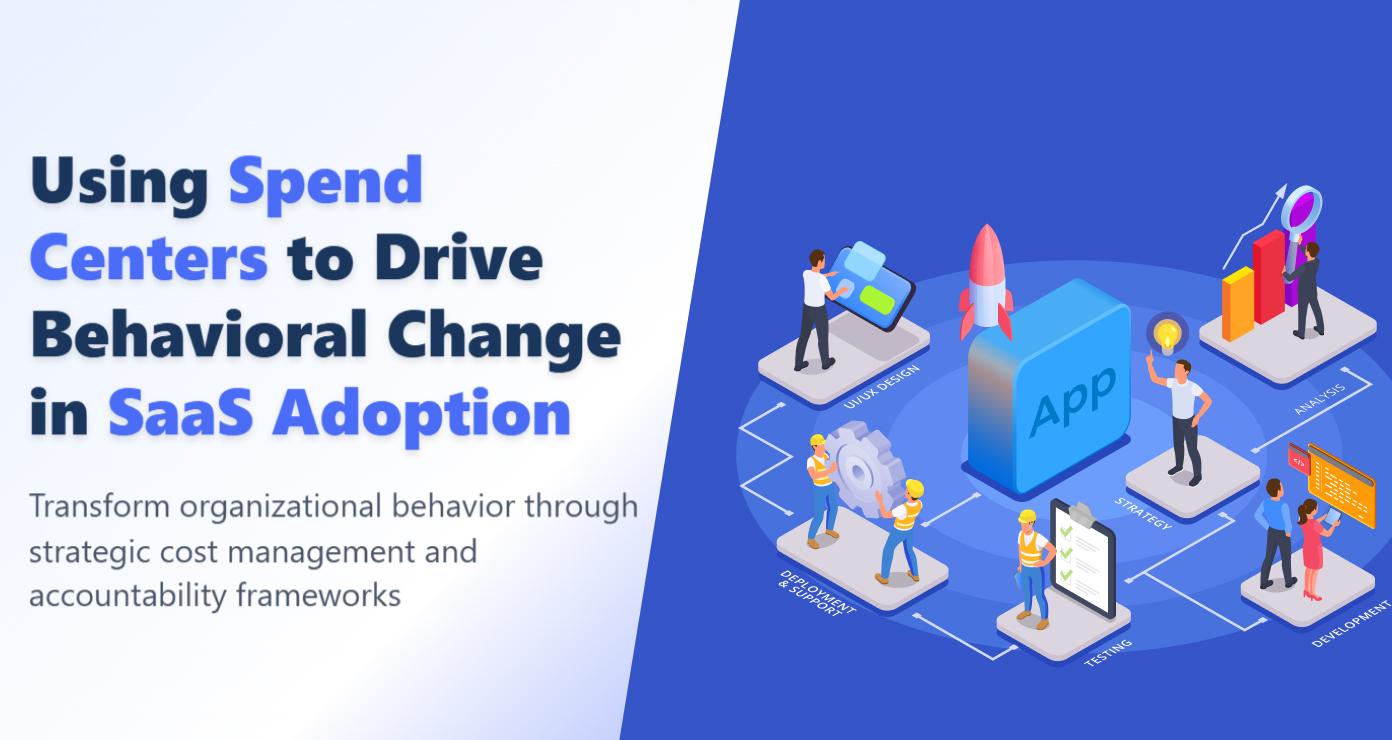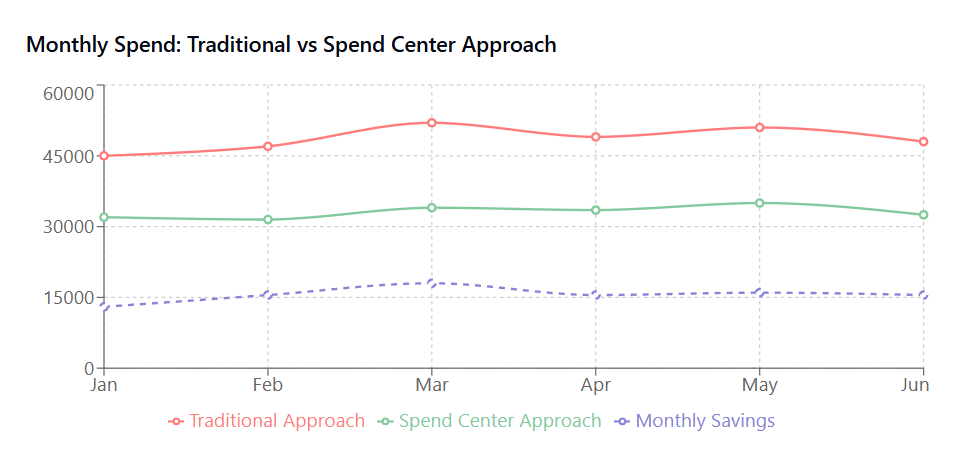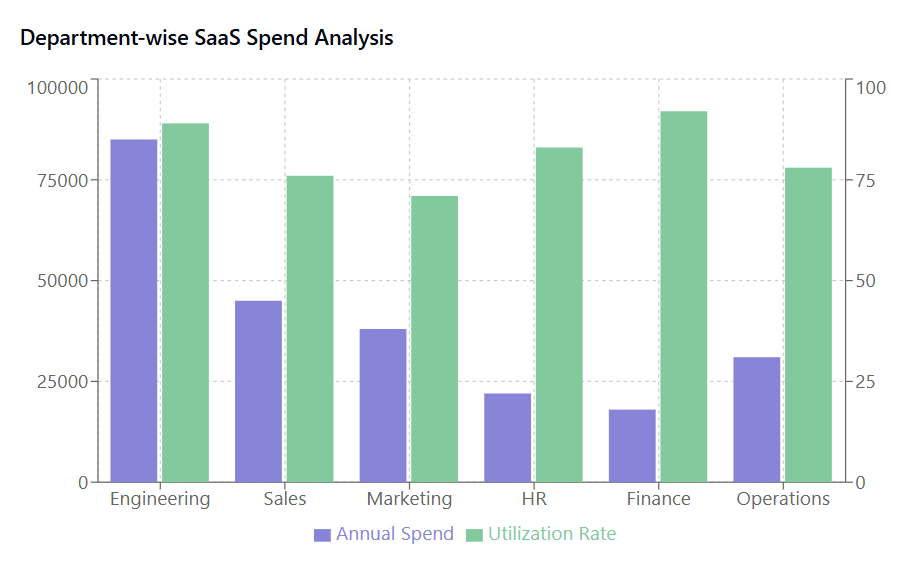
The rapid expansion of Software as a Service (SaaS) applications has fundamentally transformed how organizations access and utilize software solutions. While this shift toward cloud-based applications offers unprecedented flexibility and scalability, it has also introduced significant challenges in cost management and organizational behavior. The rise of decentralized SaaS adoption, often referred to as “shadow IT,” has led to fragmented spending patterns, redundant subscriptions, and a lack of visibility into actual software utilization across departments.
Organizations today face a critical challenge: how to harness the benefits of affordable SaaS solutions while maintaining control over costs and ensuring strategic alignment. The answer lies in implementing spend centers as a behavioral change mechanism that not only provides financial visibility but actively shapes how teams approach SaaS adoption decisions.
Spend centers represent more than just a financial reporting structure; they serve as powerful tools for driving behavioral change in SaaS adoption by creating accountability, transparency, and strategic decision-making frameworks. By establishing clear ownership and responsibility for software expenses, organizations can transform their approach to SaaS spend management, moving from reactive cost control to proactive strategic planning.
Understanding Spend Centers in the SaaS Context
A spend center in the context of SaaS management is a designated organizational unit responsible for specific software-related expenses, usage tracking, and decision-making authority. Unlike traditional cost centers that merely allocate expenses, spend centers actively engage in the procurement, utilization, and optimization of SaaS applications within their domain.
The concept extends beyond simple budget allocation to encompass comprehensive responsibility for cost-effective SaaS tools selection, ongoing usage monitoring, and strategic alignment with business objectives. Spend centers create a framework where departments or teams become active stakeholders in their software investment decisions rather than passive consumers of centrally-managed resources.
Effective spend centers typically include clearly defined boundaries of responsibility, established approval processes for new SaaS applications, regular usage monitoring and reporting mechanisms, and specific performance metrics tied to software ROI. This structure enables organizations to implement automated SaaS tracking while maintaining human oversight and strategic decision-making capabilities.
The behavioral impact of spend centers becomes evident when teams understand that their software decisions directly affect their allocated budgets and performance metrics. This awareness drives more thoughtful evaluation of SaaS alternatives, encourages the elimination of redundant licenses, and promotes collaborative decision-making around software investments.
Organizations implementing spend centers often discover that the mere act of establishing ownership and accountability leads to immediate improvements in software utilization patterns. Teams begin to question whether they truly need multiple tools serving similar functions, start tracking actual usage more carefully, and develop stronger business cases for new software acquisitions.
The Psychology of Financial Accountability
Understanding the psychological drivers behind spending behavior is crucial for designing effective spend center strategies. When individuals and teams have direct visibility into their software expenses and understand the impact on their allocated budgets, their decision-making patterns fundamentally change.
Research in behavioral economics demonstrates that people make more careful decisions when they perceive a direct connection between their choices and outcomes. In the context of SaaS adoption, this translates to more thorough evaluation of affordable cloud solutions for startups and established organizations alike, increased scrutiny of subscription renewals, and greater collaboration in software selection processes.
The concept of loss aversion plays a significant role in spend center effectiveness. When teams understand that excessive software spending reduces their available budget for other priorities, they become naturally motivated to optimize their SaaS portfolio. This psychological principle drives teams to actively seek cost-effective app management solutions and eliminate underutilized subscriptions.
Transparency also creates peer accountability within organizations. When spending patterns are visible across departments, teams naturally compare their efficiency and utilization rates. This social pressure often proves more effective than top-down mandates in driving behavioral change toward more responsible SaaS adoption practices.
The establishment of spend centers also addresses the psychological tendency toward “free rider” behavior, where individuals make decisions assuming someone else will bear the costs. By creating clear ownership and responsibility, organizations eliminate this disconnect and ensure that decision-makers understand the full implications of their choices.
Implementing Behavioral Change Through Spend Centers
The implementation of spend centers requires a strategic approach that balances autonomy with accountability. Organizations must design systems that empower teams to make software decisions while ensuring alignment with broader cost management objectives and security requirements.
Successful implementation begins with establishing clear governance frameworks that define approval thresholds, evaluation criteria, and reporting requirements. These frameworks should balance the need for control app expenses with the agility required for teams to access necessary tools quickly. The goal is to create processes that encourage thoughtful decision-making without creating bureaucratic obstacles that drive teams toward unauthorized software adoption.
Education and training play crucial roles in behavioral change initiatives. Teams need to understand not only the mechanics of spend center operations but also the broader strategic implications of their software decisions. This includes training on evaluating SaaS alternatives, understanding total cost of ownership, and recognizing the impact of software choices on organizational security and compliance.
The integration of automated app tracking capabilities enables real-time visibility into usage patterns and spending trends. This technology foundation supports behavioral change by providing immediate feedback on the consequences of software decisions, allowing teams to adjust their approaches before problems become entrenched.
Regular review processes create opportunities for continuous improvement and learning. These reviews should focus not only on financial performance but also on usage patterns, business value delivered, and lessons learned from both successful and unsuccessful software investments. This creates a culture of continuous optimization rather than one-time cost reduction.
Organizations should also implement recognition and incentive programs that reward teams for demonstrating effective SaaS management practices. This might include recognition for teams that successfully optimize their software portfolios, identify significant cost savings, or develop innovative approaches to business software savings.
Technology Infrastructure for Spend Center Success
The effectiveness of spend centers depends heavily on having robust technology infrastructure that supports visibility, control, and optimization of SaaS investments. Modern cloud cost management tools provide the foundation for implementing comprehensive spend center strategies by automating tracking, reporting, and analysis of software utilization patterns.
Centralized app management platforms enable organizations to maintain visibility across all SaaS applications while delegating appropriate decision-making authority to individual spend centers. These platforms should provide real-time dashboards that show current spending, usage trends, and upcoming renewal dates, enabling proactive management rather than reactive responses to cost overruns.
Integration capabilities are essential for creating seamless workflows between spend center operations and existing financial systems. Organizations need platforms that can automatically categorize expenses, generate reports aligned with spend center boundaries, and provide APIs for integration with procurement and approval workflows.
Advanced analytics capabilities enable spend centers to identify optimization opportunities that might not be apparent through simple usage reporting. This includes identifying overlapping functionality across different applications, detecting underutilized licenses that could be reassigned or canceled, and predicting future usage patterns based on historical trends.
The technology infrastructure should also support automated policy enforcement, such as preventing the purchase of applications that duplicate existing functionality or exceed established spending thresholds without appropriate approvals. This automation reduces the administrative burden on spend center managers while ensuring consistent policy application.
Budget-friendly cloud solutions for infrastructure management complement SaaS spend center strategies by providing cost-effective platforms for hosting internal applications and reducing dependence on external SaaS providers where appropriate. This hybrid approach gives organizations maximum flexibility in optimizing their overall software portfolio.
Measuring Success and Driving Continuous Improvement
Establishing meaningful metrics is essential for evaluating the effectiveness of spend center initiatives and driving continuous behavioral change. Organizations should develop comprehensive measurement frameworks that capture both financial and operational outcomes of their spend center strategies.
Financial metrics should include obvious measures such as total SaaS spending, cost per user, and percentage of budget allocated to underutilized applications. However, more sophisticated organizations also track metrics such as software ROI, cost avoidance through alternative selection, and the efficiency of spend center decision-making processes.
Operational metrics provide insights into how effectively spend centers are changing organizational behavior around SaaS adoption. These might include the average time required for software procurement, the percentage of applications that meet utilization targets, and the frequency of policy violations or unauthorized software installations.
User satisfaction metrics help ensure that cost optimization efforts don’t come at the expense of productivity or employee satisfaction. Organizations should regularly survey users about their access to necessary tools, the effectiveness of approval processes, and their overall satisfaction with available software options.
Benchmarking against industry standards and peer organizations provides valuable context for evaluating spend center performance. This external perspective helps organizations understand whether their optimization efforts are achieving competitive results and identify areas for improvement.
Regular analysis of spending patterns can reveal important insights about organizational behavior and effectiveness of different spend center strategies. For example, organizations might discover that certain departments consistently demonstrate better SaaS management practices and can serve as models for other teams.
The measurement framework should also include leading indicators that predict future performance rather than simply reporting historical results. These might include metrics such as the percentage of applications undergoing regular usage reviews, the rate of proactive license optimization, and the effectiveness of training programs in changing software selection behavior.

Overcoming Implementation Challenges
Organizations implementing spend center strategies often encounter resistance to change, concerns about reduced autonomy, and technical challenges related to tracking and reporting capabilities. Addressing these challenges proactively is essential for successful behavioral change initiatives.
Change management strategies should acknowledge that spend centers represent a significant shift in how organizations approach software decision-making. Teams accustomed to unlimited access to software tools may initially resist new approval processes and spending constraints. Effective communication about the strategic benefits of spend centers, including improved budget predictability and reduced security risks, helps build support for new approaches.
Concerns about reduced autonomy can be addressed by designing spend center frameworks that maximize team decision-making authority within established parameters. The goal should be to eliminate bureaucratic obstacles while maintaining necessary oversight and control. This might involve establishing different approval thresholds for different types of software or giving teams more authority for renewals of proven applications.
Technical challenges often arise from the complexity of tracking SaaS usage across multiple applications and departments. Organizations should invest in comprehensive centralized SaaS management platforms that can automatically integrate with major SaaS providers and provide unified reporting across all applications. The initial investment in these platforms typically pays for itself through improved visibility and optimization opportunities.
Training and support programs are essential for helping teams adapt to new spend center processes. This should include both technical training on using spend center tools and strategic training on evaluating software options and making cost-effective decisions. Organizations should also establish clear escalation processes for situations where standard spend center processes don’t adequately address specific business needs.
Cultural transformation requires consistent leadership support and clear communication about the strategic importance of SaaS cost management. Leaders should model appropriate behaviors by following spend center processes themselves and recognizing teams that demonstrate effective software management practices.
Industry-Specific Considerations
Different industries face unique challenges and opportunities when implementing spend center strategies for SaaS management. Understanding these industry-specific factors helps organizations tailor their approaches for maximum effectiveness.
Technology companies often have high SaaS adoption rates and sophisticated user bases that demand access to cutting-edge tools. Spend centers in these organizations should focus on balancing innovation with cost control, possibly implementing separate budget categories for experimental tools and proven productivity applications.
Healthcare organizations must consider strict compliance requirements and data security concerns when implementing spend center strategies. These organizations may need more restrictive approval processes and mandatory security reviews for new SaaS applications, which should be balanced against the need for clinical and administrative efficiency.
Financial services companies face similar regulatory constraints but may have greater budget flexibility for software investments. Spend centers in these organizations should emphasize risk management and compliance tracking in addition to cost optimization.
Retail organizations often have seasonal variations in software needs and may benefit from flexible spend center frameworks that accommodate these cyclical patterns. They may also need to balance central control with the autonomy required for regional operations to respond quickly to local market conditions.
Manufacturing companies may have more limited SaaS adoption but face unique challenges related to operational technology integration and supply chain software requirements. Spend centers should account for these specialized needs while still promoting cost-effective software selection.
Educational institutions often have limited budgets but diverse user communities with varying software needs. Spend center strategies should emphasize maximizing value from limited resources while ensuring broad access to necessary educational and administrative tools.

Future Trends and Evolution
The evolution of SaaS markets and organizational needs continues to create new opportunities and challenges for spend center strategies. Organizations should prepare for emerging trends that will influence how they approach behavioral change in SaaS adoption.
Artificial intelligence and machine learning capabilities are increasingly being integrated into SaaS spend management tools, enabling more sophisticated analysis of usage patterns and optimization opportunities. These capabilities will help spend centers make more data-driven decisions and identify optimization opportunities that might not be apparent through traditional analysis.
The growing emphasis on environmental sustainability is driving organizations to consider the carbon footprint of their software choices. Future spend center strategies may need to incorporate environmental impact metrics alongside traditional cost and utilization measures.
Increased focus on data privacy and security continues to influence SaaS selection criteria. Spend centers will need to incorporate more sophisticated security evaluation processes and may need to balance cost optimization with risk management considerations.
The rise of low-code and no-code platforms is changing how organizations approach software development and deployment. Spend centers may need to expand their scope to include these platforms and the applications built on them, requiring new approaches to tracking and optimization.
Remote and hybrid work models are creating new patterns of software usage and changing the economics of SaaS investments. Organizations may need to adapt their spend center strategies to account for more distributed user bases and changing collaboration patterns.
The increasing sophistication of SaaS marketplace and procurement platforms is creating new opportunities for automating spend center processes while maintaining appropriate oversight and control.
Conclusion
Using spend centers to drive behavioral change in SaaS adoption represents a strategic approach to addressing one of the most significant challenges facing modern organizations: balancing the benefits of cloud-based software solutions with the need for cost control and strategic alignment. Through the implementation of comprehensive spend center frameworks, organizations can transform their approach to SaaS management from reactive cost control to proactive strategic optimization.
The success of spend center initiatives depends on understanding the psychological drivers of spending behavior, implementing appropriate technology infrastructure, and creating measurement frameworks that drive continuous improvement. Organizations that successfully implement these strategies typically see significant improvements in software utilization rates, cost optimization, and strategic alignment of their SaaS portfolios.
The behavioral changes driven by effective spend centers extend beyond simple cost reduction to include improved decision-making processes, enhanced collaboration around software selection, and greater organizational awareness of the strategic importance of software investments. These changes create lasting value that extends well beyond immediate financial benefits.
As the SaaS ecosystem continues to evolve, organizations with well-established spend center strategies will be better positioned to adapt to new challenges and opportunities. The frameworks and behavioral patterns established through spend center implementation provide a foundation for ongoing optimization and strategic software management.
For organizations considering implementing spend center strategies, the key to success lies in balancing control with autonomy, investing in appropriate technology infrastructure, and maintaining focus on behavioral change rather than simply implementing new processes. With proper planning and execution, spend centers can become powerful tools for transforming organizational approaches to SaaS adoption and creating sustainable competitive advantages through optimized software investments.
The journey toward effective SaaS spend management through spend centers requires commitment, resources, and patience, but the long-term benefits in terms of cost optimization, strategic alignment, and organizational capability make this investment worthwhile for organizations serious about maximizing the value of their software investments in the digital age.

